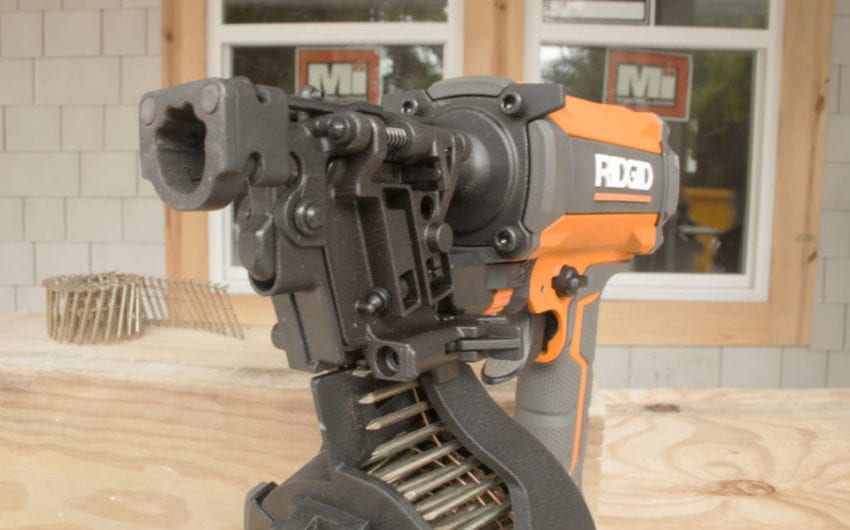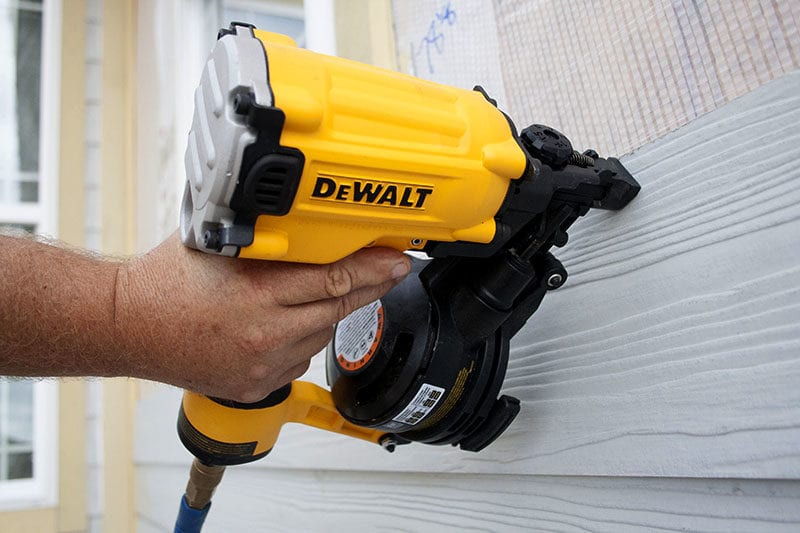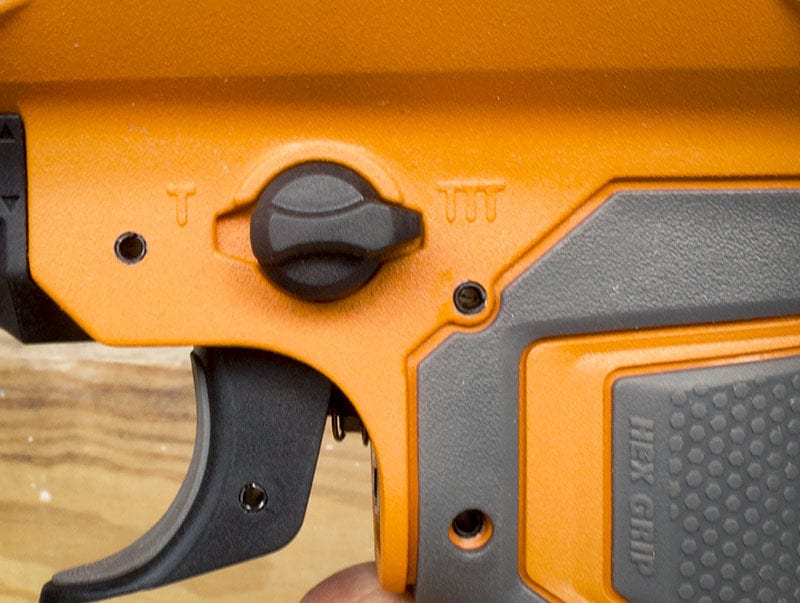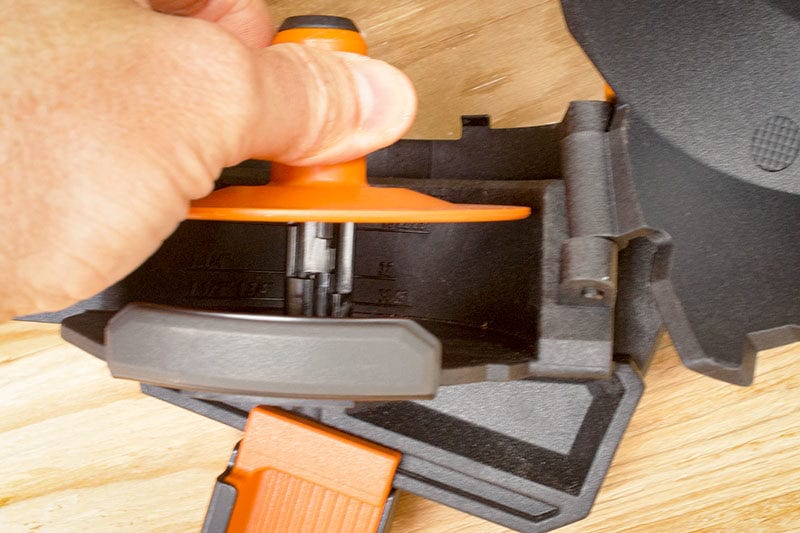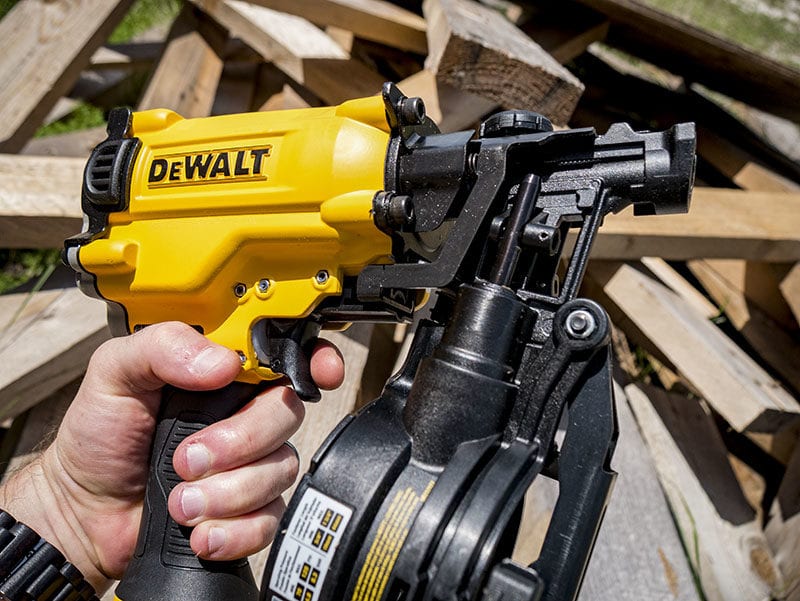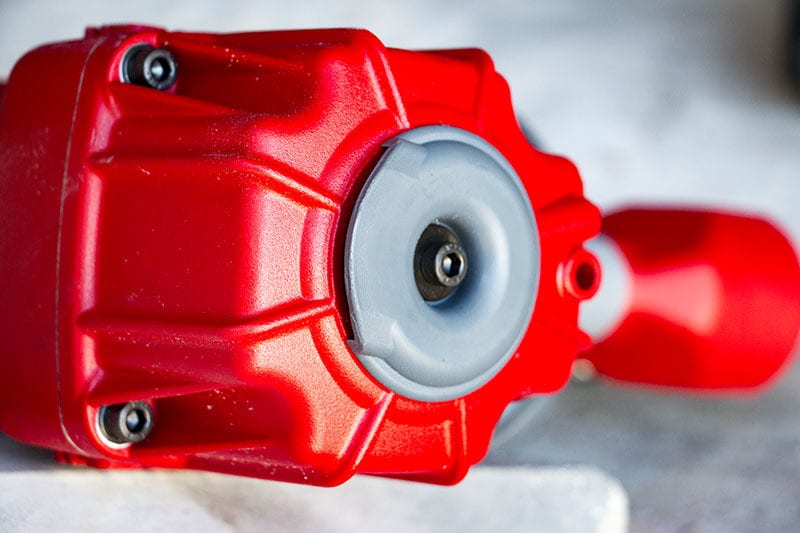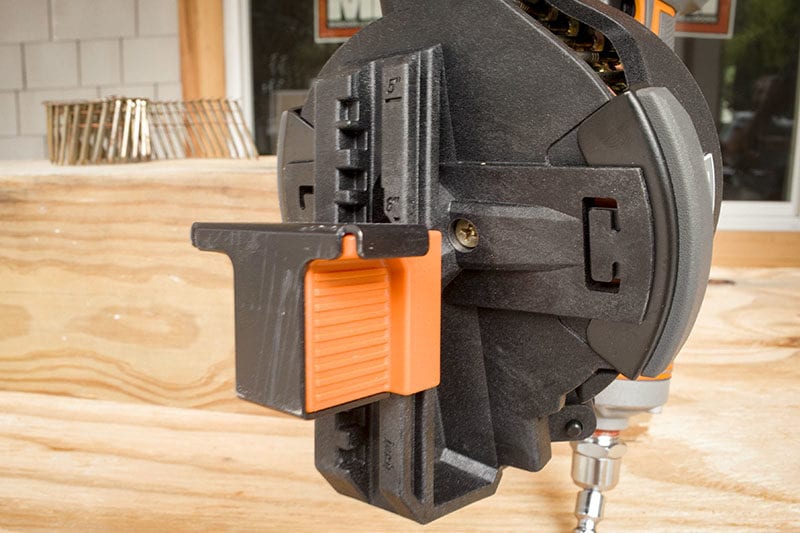It’s a safe bet that most nails driven on modern construction sites aren’t put there by a hammer. Framing, siding, and roofing nailers have made the job faster and easier, so it’s no surprise they get put in the game while hammers ride the bench—at least for the bulk of the work. We compared the best framing nailers to see which tool performed the best. Now, we’re focusing on the features to look for in a roofing nailer or siding nailer.
Table of Contents
- Stick Nailers vs Coil Roofing Nailers
- Less Weight Makes for Better Ergonomics in a Roofing Nailer
- Look for Roofing Nailers with Good Balance
- Roofing Nailers Need a Comfortable Grip
- Features to Look for in a Roofing or Siding Nailer
- Pneumatic vs Cordless or Battery-Powered Roofing Nailers
- Roofing Nailer Maintenance and Final Thoughts
Stick Nailers vs Coil Roofing Nailers
You can immediately identify a roofing and/or siding nailer by the shape of the round magazine. Whereas framing nailers drive longer, smaller-headed nails (typically from a collated stick) to fasten lumber, roofing nailers drive shorter, larger-headed nails from a collated coil.
You can use these nailers to fasten asphalt shingles, house wraps, siding, and more. There’s not a huge amount of variability among these nailers. Still, some features might lead you to choose one roofing nailer over another as you look through your options. While our primary metrics are power and ergonomics, we also like to see several other features on our nailers.
Less Weight Makes for Better Ergonomics in a Roofing Nailer
Let’s start on the ergonomics side of the equation. We talk to Pros and they have lots of opinions. One place they all agree? Weight is the most important consideration when choosing a roofing nailer. When it comes to holding a tool all day long, low weight falls under one of the primary features to look for in a roofing nailer.
Securing shingles and siding is an all-day or multiple-day job. With a heavy tool, the work is brutal. It’s not only the tool weight, but the user also needs to pick up and hold heavy materials in place for nailing, which adds to the fatigue of the job.
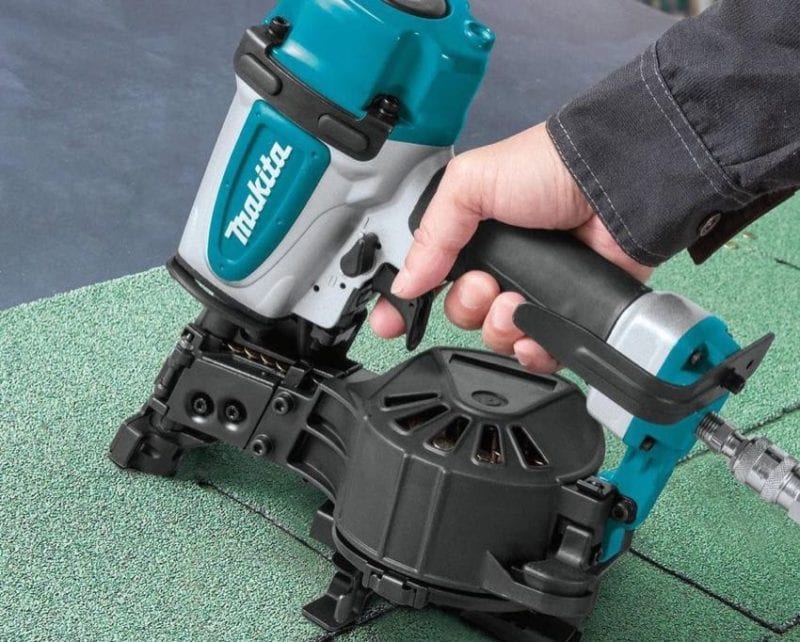
Coil roofing nailers have a larger fastener capacity than other nailer types, but that’s a double-edged sword. On the one side, work doesn’t have to stop to reload nearly as often as with a stick or framing nailer. However, these nailers typically weigh more, especially at the beginning of the coil.
For this reason, we prefer the nailer itself to be as light as possible. As long as the nailer is acceptably light and drives nails without jams, then the other features are secondary. Metabo HPT (formerly Hitachi), Makita, Bostitch, Senco, DeWalt, and Max have some incredibly light roofing nailers that weigh less than 6 pounds. Look for magnesium, aluminum, and even plastic bodies to save on weight.
Look for Roofing Nailers with Good Balance
Knowing what features to look for in a roofing nailer means understanding how a tool feels in your hand during various uses. Besides being lightweight, a nailer should be well-balanced from the head through the handle. Having a forward-leaning tool may be OK for the roof, but a better-balanced system will make siding much easier.
Roofing Nailers Need a Comfortable Grip
Holding and using a tool all day also means you want a comfortable grip. Many of these tools have decent overmold grips, but we still really like the Ridgid Hex Grip. It just stands out to us as an exceptional design. Some tools also feature a larger circumference than others on the handle. Depending on your hand size you may prefer one brand over another.
Features to Look for in a Roofing or Siding Nailer
Tool-free Depth of Drive Adjustment
Is the fastener depth easy to read and change? It should be. Since variable air supply levels make this mostly trial and error, you need the ability to easily dial in the nail drive depth. Typically, this involves activating a mechanism that moves the firing head towards and away from the piston/driver to vary the depth of drive. If the manufacturer provides a thumbwheel, ensure that it works well both with and without gloves.
We look for this feature so that we can quickly adjust any roofing nailer to properly fire into various deck materials.
Dry Fire Lockout Matters More on Pro Roofing Nailers Than Other Tools
We still shake our heads today when we look, and a pneumatic roofing nailer comes to us without this feature. Dry fire lockout prevents the nailer from firing when it doesn’t have a nail in the magazine to drive.
Many manufacturers include this feature because it avoids unnecessary wear. It also eliminates the frustration of firing a sequence of nails only to later discover the board, shingle, or material isn’t actually fastened. With shingles, this feature matters even more since you need to make sure you don’t miss a single nail in your high-wind nailing pattern.
Tool-free Firing Mode Adjustment
All nailers have a single action mode where one nail is driven for each trigger pull, but some also have a bump fire mode that allows a nail to be driven each time the nailer’s nose is depressed as long as the trigger remains pulled. Of all the features to look for in a roofing nailer, this might be the one you use most often to keep from double-firing in certain situations.
Bump fire can help you work much more quickly, but a slight danger lurks in the increased speed. If the nailer recoils and then fires, it’s possible to shoot multiple nails through the same hole, causing a potential jam.
Easy Basket or Magazine Adjustment
Roofing nailers accommodate a range of nail lengths, and the nail basket or magazine should move easily up and down. This adjustment ensures the nails feed smoothly and in alignment with the firing mechanism.
Low Trigger Pull Force
A roofer will drive hundreds of nails per day with a roofing nailer. The repetitive force of the trigger pull can add up to fatigue and pain over time. This is especially true in single-action firing mode. It’s important that the trigger pull force is light. For bump fire, you’re holding the trigger down, so a high spring tension will also work against you.
Roofing Nailers Need Easy Jam Clearing Features
Roofing nailers should seldom jam when properly maintained. Still, when they do, it often requires tools to free the magazine and get at the offending nail. Some models include either a tool-free magazine release or a jam-release latch. Either feature makes jam-clearing an easier prospect should the worst happen. Still, the best guns will jam up less often, pushing this feature further down on our priority list.
Adjustable Exhaust Vent
Many nailers have an adjustable exhaust vent that deflects the burst of air that accompanies a drive. Otherwise, the repetitive burst might blow right at you in certain positions and uses. The best exhaust position for roofing won’t be the same as for siding.
Swivel Quick Connector
A small convenience on pneumatic nailers is a swivel air connection which allows easier hose movement. You can quickly and easily add your own 1/4-inch NPT male fittings, but we prefer the flexibility of a swivel adapter. You may encounter more frequent air leaks with these types of connections. With how inexpensive they are, however, we just keep a wrench handy and replace them as needed.
Shingle Guide – VERY Optional
Some roofing nailers include a shingle guide. This acts as a jig to ensure each shingle is in the right place for nailing. Pros almost never use features like this. However, for the weekend warrior, it may speed up the work by helping you be more consistent.
Pneumatic vs Cordless or Battery-Powered Roofing Nailers
The best (and a majority of) coil roofing nailers operate via air and connect to an air compressor. These work more quickly and weigh far less than cordless models. Gas models allow for cordless or hoseless operation but have trade-offs. You get that cordless operation at the cost of a much heavier nailer.
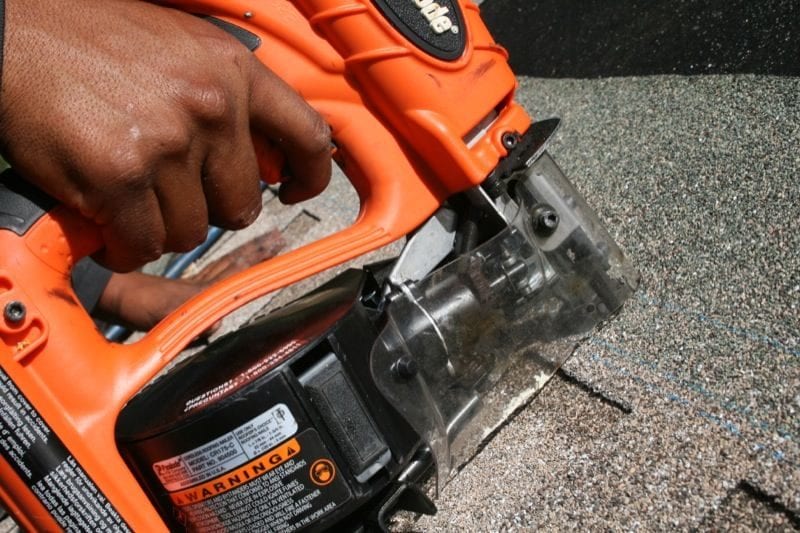
More recently, battery-only models have hit the scene. In particular, the DeWalt cordless roofing nailer uses a single 20V Max battery to drive hundreds of nails per charge.
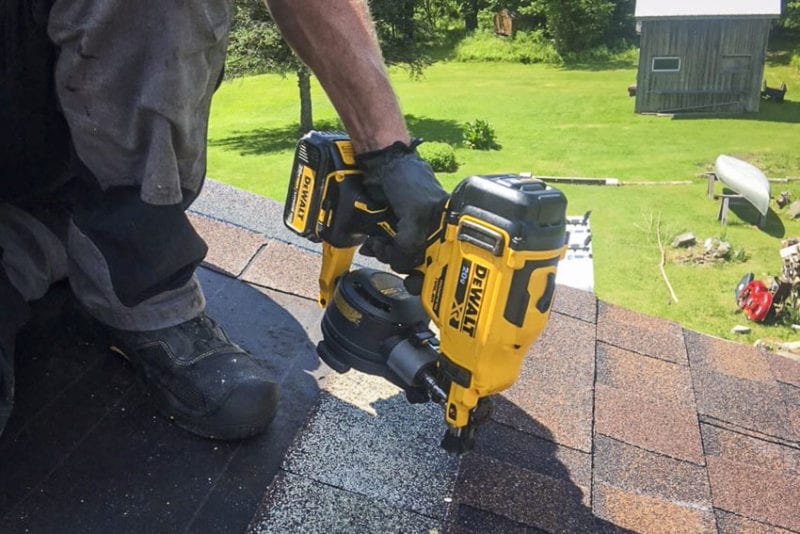
Should you buy a cordless coil roofing nailer if you’re a pro? Possibly.
We find cordless roofing nailers helpful for smaller jobs or punch list work where dragging out the compressor and hoses is inefficient. For larger jobs, however, the trade-off for weight and expense of gas makes them impractical. I have yet to see a battery-powered or gas-powered roofing nailer used by anyone to shingle an entire residential roof. If I did, I’d likely be eating popcorn.
Roofing Nailer Maintenance and Final Thoughts
You’re going to need to oil a coil roofing or siding nailer quite often—at least once a day. Refer to the manufacturer’s instructions for proper maintenance.
Now that you know what to look for in a Pro roofing nailer, check out a couple of our most popular reviews and our tips on how to use a roofing nailer like a Pro!
- Ridgid R175RNF Coil Roofing Nailer
- DeWalt DW45RN Coil Roofing Nailer
- Senco SCN65 Coil Nailer
- Paslode CR175C Roofing Nailer
We hope this guide has helped you know what to look for in a Pro roofing nailer. If you’re a Pro and you have tips about choosing a roofing nailer, add them in the comments below—or hit us up on Facebook, Instagram, and Twitter!

